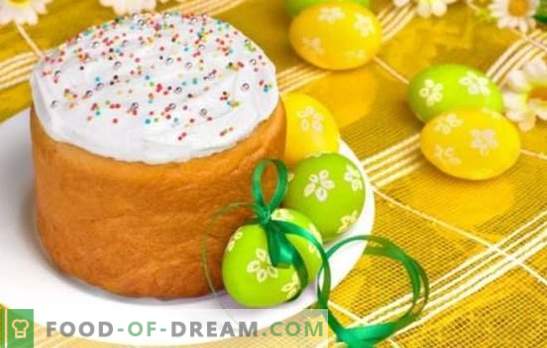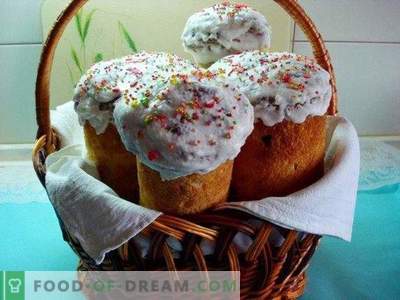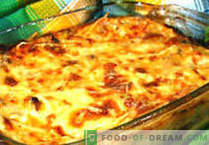
Once a year, the entire Orthodox part of humanity prepares for the brightest and most important holiday of Christians, Easter.
Of course, the main concern, after the longest post, which symbolizes spiritual cleansing, is the festive table, where Easter or Easter cake, consecrated in the temple, takes the main place.
It starts with a solemn dinner or, rather, breakfast.
Easter recipes, not only in each individual region, but also in each family - their own. They are often passed from generation to generation.
Many women cook Easter and bake cakes, using the secrets of their grandmothers, although the traditional exchange of experience does not lose relevance.
One of the relatively new recipes, which appeared in recent decades, was the recipe for Easter on kefir, with and without yeast.
It is clear that kefir in fresh and sweet dough is necessary, as a means to ensure the pomp and ease of baking. But the use of kefir in yeast dough seems more like a desire to come up with something new, because the activity and effectiveness of dairy bacteria against the background of yeast fades.
Although there is still some benefit from such a tandem. Let's take a look, at least in general terms, how yeasts work with lacto-and bifidus bacteria together.
Easter on kefir - basic technological principles
Many housewives are familiar with the secrets of making yeast dough. It should be noted that in the standard norms of the baking industry and confectionery shops there is no such thing as a dough on kefir with yeast, although in practice this method of making dough is quite common.
At first glance, the use of kefir in combination with yeast seems meaningless, because yeast and lactic acid bacteria are representatives of the same, most numerous colony of living organisms on earth. Yeast and dairy bacteria, however, belong to different types of microorganisms and they feed differently: yeast prefer sugar, and bifidobacteria and lacto bacteria prefer dairy products. But both of these groups in the process of life emit carbon dioxide, causing the fermentation of dough. On the other hand, they do not interfere with each other and can coexist in the same environment. Therefore, it is quite possible to use kefir and yeast for dough at the same time. True, it should be noted that the action of yeast, nevertheless, is more effective than their “colleagues in the workshop”.
If yeast is not supposed to be used for making dough, then in order to start the reaction of carbon dioxide emission, which will ensure dough rise, it is necessary to add components that provide an alkaline medium: soda, ammonium or other additives allowed for use in the food industry.
In the case of the combination of yeast and dairy bacteria in the total mass, the use of leavening agents is not necessary.
1. “Red Easter” on kefir without yeast
Products:
Flour 450g
Salt, fine
Sugar 300 g
Kefir 200 ml
Soda 5 g
Raspberries, fresh or frozen 180 g
Eggs 3 pcs.
Vanilla 3g
Lemon (juice) 20 ml
Oil (82.5%) 140 g
Cooking Procedure:
Mix flour with soda and salt. Beat butter until fluffy with sugar and eggs, hammering them one by one. Add the vanilla. Rub the berries through a sieve to remove the seeds. Combine raspberry juice with kefir and mix. For a more saturated color, you can add food coloring.
Add kefir and flour to the oil-egg mixture in turn, continuing to beat the dough.
Line up the cylindrical forms with oiled parchment and pour the prepared dough into them, filling it in 3/4 volume.
Bake for half an hour at 180C. Check the readiness of the products with a wooden stick. Remove the cooled pastries from the mold and decorate the top with white icing or whipped cream, sugar powder or raspberry.
2. Curd Easter on kefir without yeast: a recipe for Russian cuisine
Product Composition:
Whole milk 5.0 l
Raisin, dark 150 g
250 g oil
Salt
Kefir 1.0 L
Sugar 0.5 kg
Eggs 10 pcs.
Candied fruit 350 g
Vanilla
Rum or extract
Cooking Procedure:
In a large saucepan, heat the milk to 40C: it is better to buy homemade (farmer), whole, with a high percentage of fat. Pour kefir, salt into the heated milk. Stir and leave the pan, wait until most of the whey settles to the bottom of the dish. Line gauze with a sieve or colander placed on a pallet. Collect the curd mass on the surface of the pan with a slotted spoon and transfer it to gauze. After wrapping the edges of the gauze, install a press (use a jar of water) to remove the remaining whey from the curd.
Next, wipe the curd and combine it with softened butter, add vanilla and rum extract, prepared raisins, candied fruits.
Separate the yolks from the proteins, rub them with sugar, add to the whipped whites and mix. Gently, piece by piece, add the curd mass, stirring with a spoon or spatula, in the direction from the bottom up, so as not to destroy the pomp of the egg mass.
Turn on the oven at 110-120C. At the bottom, install a pan filled with water and heat the water to a boil. Lay out the curd dough into molds and place on the middle grid of the oven. Reduce the temperature to 80-90C and warm the Easter with steam for 60-70 minutes, if necessary, pouring water into the pan.
Invert the cooled forms on a dish and lay out Easter. Put candied fruit “XB”, sprinkle with colored sugar and put in cold.
3. Curd Easter on kefir without yeast with cherries in chocolate icing
Product Composition:
Flour 150 g
Cherry 200 g
Cottage cheese (18%) 1.0 kg
Soda 25 g
Sugar 350 g
Kefir 250 ml
Milk chocolate 400 g
7 eggs
Butter 150g
Vanilla extract 20 drops
Cooking Procedure:
Add butter to the curd, rub through a sieve. Pound proteins with sugar, combine with pre-cooled and whipped proteins. In kefir, add soda, vanilla, lightly salt to emphasize the taste. Combining kefir with curd mass, add flour, knead the dough. Put fresh or frozen cherries into it. Combine the prepared mass with the eggs, mix and spread into forms, filling them to 2/3 of the height.
Bake up to 45 minutes at 180C. It is necessary to take products from a form cooled to room temperature. Melt chocolate on the steam bath and cover it with Easter.
4. Easter on kefir with yeast: cake with saffron
Product List: Kefir (2.5%) 250 g
Flour 500 g
Eggs 4 pcs.
Candied 100 g
Oil 100 g
Dry yeast 8 g
Saffron 2 g
Rum 50 ml
Orange Peel 60 g
Sugar 450g
Vanilla (powder, crystalline) 2 g
White Raisin 120g
Cooking Procedure:
Separate fresh egg whites from yolks and refrigerate for a while. Combine yolks with sugar, add soft butter, rum, orange zest and saffron boiled in 50 ml of boiling water. In kefir, add a third of the flour, a little sugar, yeast; Stir and allow to stand warm for the yeast to start working. Add the cooked baking dish, add the rest of the flour and wait, knead the dough, cover it and place it closer to the plate for proofing. Set it off when it rises, put the raisins and candied fruits, knead, until it starts to easily peel off from the hands and dishes. If necessary (if the flour has a high humidity) add the flour. Forms for Easter cakes grease and fill them with dough at 25%. Put in the heat, wait for the rise and bake. Check the readiness of cakes inside with a wooden skewer.
Whisk cooled proteins, gradually add remaining sugar, vanilla. Grease the upper part of the cooled cakes with cooked icing, decorate with sugar powder or candied fruit.
5. Almond Easter on kefir with yeast
Product Composition:
Instant yeast 20 g
Flour 450g
Raisin 250 g
Almond chips 100 g
Dried apricots 140 g
Kefir 150 ml
Fresh eggs 6 pcs.
Oil 200 g
Sugar 350 g
“Amaretto” 100 ml
Vanilla 3g
Procedure:
Egg yolks, sugar, butter combine and rub. Sift the flour and combine 100 g with warm yogurt and yeast, adding 2-3 tablespoons of sugar; Connect this part with the egg-butter baking. Put in heat, covering the brew. When a stable foam appears, add vanilla and liqueur combined with dried fruit and nut crumb flour. Knead the dough. After lifting divide into portions and put into prepared forms. Let the cakes rise again and bake.
Prepare a protein glaze, as indicated in the previous recipe and decorate Easter on yogurt with yeast.
6. Easter on kefir with yeast, orange
Dough Products:
Sugar 350 g
Protein 7 pcs.
Kefir (2.5%) 250 ml
Oranges 2 pcs.
Flour 1.2 kg
Butter (or margarine) 100 g
Powder 50 g
Live yeast 80 g
Yolks, chicken 7 pcs.
Vanillin 4g
Powder 200 g
Cooking Procedure:
With oranges, remove the zest, release the pulp from the peel and membrane; Smash the flesh with a blender, combining with kefir, adding 100 g of granulated sugar, 2 g of vanilla. Combine the butter with the remaining sugar, whisk, adding one yolk one by one. Combine both cooked masses and add the yeast and fourth of the flour. Let the dough rise and add the rest of the flour. Knead well, put it into forms, having prepared them in advance. When the cakes will rise to the edge of the form, send them to the preheated oven. After baking, let cool, remove from the form, grease with icing prepared from cooled proteins, powder and 2 g of vanillin. Garnish with powdered sugar.
7. Easter on kefir with yeast and fructose
Easter cake is traditionally prepared with the addition of large amounts of sugar, eggs, fat. But for those who, even on the Great Feast, cannot afford such baking, there is a recipe no less sweet and tasty, but at the same time dietary.
Product List:
Dry yeast 7 g
Kefir 0.5 L
Flour 0.5 kg
Fructose 250 g
Vanilla 3g
Dried fruits 300 g
For milk syrup:
70 ml whole milk
50 ml of raspberry juice
150 g of fructose
Cooking:
Sift flour, add vanilla and fructose. Dissolve the yeast in warm kefir and combine it with flour. In the risen dough, add the prepared dried fruit, mix, distribute in the form, transfer the capacity for proofing to a warm place. Bake after increasing the dough by 2 times.
Boil milk with raspberry juice and add fructose (150 g). Cook until thick. To glaze on the surface of the cakes, add at the end of cooking 20 g of oil.
Easter on kefir - tips and tricks
Too much soda can ruin baked goods. Soda promotes quick drying of baked dough products. Its excessive presence in baking is unpleasant to the taste, and the ready pastry has an ugly gray tint. In yeast dough it is also important not to overdo it with the use of yeast. Their excess will give the dough a sour smell; baking, supersaturated with yeast, when stored quickly becomes covered with mold and becomes unsuitable for consumption.
The consistency of dough for Easter on kefir without yeast should be softer. Dairy bacteria are less active, therefore it is desirable to add less flour. Raw dough should slightly “float”. After baking, the excess moisture contained in kefir will evaporate, and the milk protein will turn into elastic and dense fibers that will provide the desired baking texture.
It is very important to pay attention to the quality and freshness of the products, because it is the key to success for any dough products.
Household appliances help to reduce the time spent now, but still it is better to knead the dough with your hands. No wonder our grandmothers often repeated that the dough must be felt that it is alive. There are other tips for making dough, which, at first glance, seem to be fiction or superstition. But, if you think about it, then there is a scientific justification in these councils. Remember how a grandmother in her childhood did not even allow her to go into the kitchen when she put on a cake for Easter cakes. These prohibitions are explained not by prejudice, but by the fact that yeast dough does not like sudden changes in temperature, drafts, sudden and sharp mechanical vibrations. It turns out that the grandmothers, not knowing physics and chemistry, were absolutely right.










